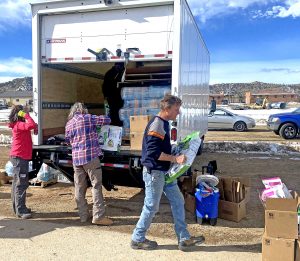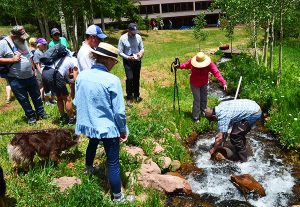TRINIDAD — Derek Navarette, Las Animas County Undersheriff, presented the annual sheriff’s report for 2015 to the Las Animas County Commission during the regular meeting February,16, 2016. The report looked at two areas: activities for 2015 and expenditures for 2015. The undersheriff noted part of the expenditures report focused on spending for January 2016 as the department looks closer at its spending in light of the budgetary problems they faced in 2015. The sheriff’s department is still receiving bills from various vendors that will need to be reconciled for fiscal year 2015. The sheriff will also be operating several DUI enforcements over the next several months, along with two “Click it or Ticket” seat belt enforcements in March and May. Both operations will generate overtime, with state grants funding the operations. The item that generated the most discussion was the area of “civil servers”, the serving of papers issued by both the courts in
Las Animas County and lawyers. Reimbursements for the work are usually paid by the attorneys in the case of witnesses, divorces, or other civil actions. The sheriff’s deputies also serve papers on criminal actions or court decisions, and where offenders are ordered to report to jail. In the event that a person is to be transported by the sheriff’s department, the cost per mile is usually $30 though sometimes it can be more. Navarette also noted the department is no longer operating a K-9 unit, even though they still had a dog with a trained handler, however the dog needs training. The other problem with the unit is liability and the cost of insurance. The county commission heard from county assessor Jody Amato concerning Pictometry. Pictometry International Corporation, a company that developed software allowing aerial photographs to be viewed from oblique angles, will be photographing Las Animas County beginning in March. The purpose of the fly over photography will help the county assessor’s office to better assess the tax on buildings in a more efficient way. Compared to the way the office is counting buildings now, by sending an assessor to the property, sometimes only to encounter a locked gate that stops the assessment, the new method will increase the work output of the office along with an increase in taxes. The information gathered by aerial photography will be compared to current records in the assessor’s office such as parcel maps and GIS data. As the county collects more taxes through this method of assessment, an increase of about 100-150 new structures may be found in the first year, generating close to $130 thousand in revenue, which will still face the demands of TABoR. An increase in tax revenue over the anticipated amount will have to be returned to taxpayers and the mill levy will be decreased. This would force the county into more draconian austerity measures, worse than the current problems the sheriff’s department faced in 2015. To help loosen the budget impacts of increased revenues on the mill levy, the county will be asking voters to approve a DeBrucing measure that will freeze the mill levy at its current rate of 8.707 percent. However if the county’s revenue grows more than 5.5 percent, the county will have to issue tax credits for the following year. The total cost of the program is $458,087.31, and is spread over three years beginning in 2016 with a payment of $152,695.77 per year.




